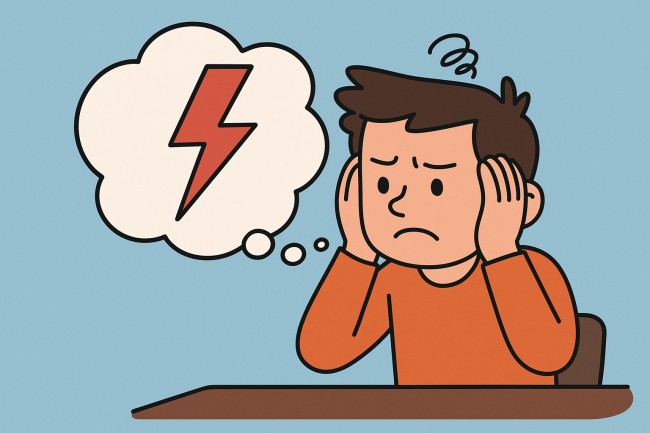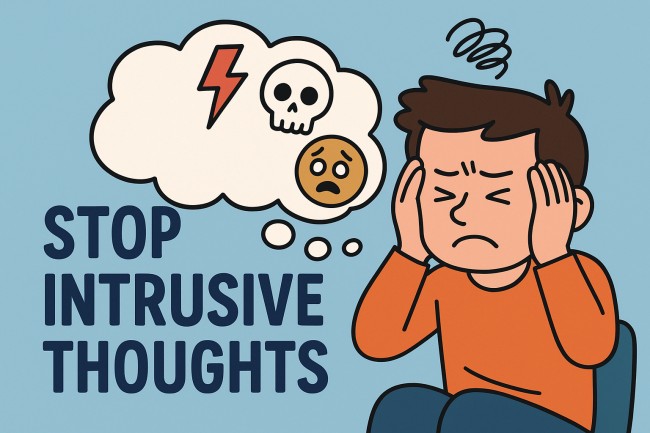The mind is a wild horse. Sometimes it gallops. Sometimes it bucks. And sometimes it refuses to stop running in circles. Those circles? They are the intrusive thoughts and overthinking loops that eat hours, sleep, and joy.
If you have ever laid in bed at 3 a.m., replaying one tiny conversation from two weeks ago, you know this beast well. The search is always the same – how to stop intrusive thoughts and breathe easy again.
This isn’t a light subject. It’s one that scratches deep into how the brain works, how we treat ourselves, and how we learn to live with the noise inside. So let’s wrestle with it.
What Are Intrusive Thoughts, Really?
First, clear the air. Intrusive thoughts aren’t a sign you’re broken. They happen to everyone. Yes – everyone. The brain sometimes coughs up ideas, images, or fears that feel alien. Dark. Random.
Even scary. One moment you’re sipping coffee, the next you imagine spilling it on your boss’s laptop. Or worse, you picture yourself shouting something cruel at someone you love.
These thoughts aren’t commands. They aren’t prophecies. They are simply sparks of electrical chatter. Most people let them pass. But if you’ve got a mind prone to anxiety or perfectionism, you might grab hold of that spark and fan it into a fire. That’s when it shifts from fleeting thought into intrusive thought.
Overthinking: The Twin Problem
Intrusive thoughts rarely walk alone. Overthinking tags along. The brain keeps gnawing on the same bone. You replay what you said. You rehearse what you should have said. You spin stories about what might happen. And the more you chew on it, the tougher it gets.
The trap? Overthinking feels productive. It feels like solving. But it’s really just spinning tires in mud. The harder you push, the deeper you sink.
Why the Brain Loves These Loops
Strange thing – the brain thinks it’s protecting you. Intrusive thoughts often come from fear centers in the mind. Overthinking comes from the problem-solving engine. Mix fear and problem-solving and you’ve got an endless loop.
Here’s the kicker: your mind is addicted to certainty. It wants answers, closure, guarantees. But life doesn’t give those easily. So the brain invents endless “what ifs” trying to lock things down.
How to Stop Intrusive Thoughts

The very first step is the hardest. Notice the thought. Call it what it is: just a thought. Don’t argue with it. Don’t shove it away. Don’t treat it as truth.
Think of it like a train rushing through a station. You can watch it pass. You don’t have to jump aboard. The power comes in realizing you are the observer, not the thought itself.
1. Don’t Fight, Label Instead
The paradox is cruel: the harder you try not to think about something, the stronger it returns. It’s the old “don’t think of a pink elephant” trick. Fight creates fuel.
Instead, label it. “That’s an intrusive thought.” “That’s my brain doing its overthinking dance.” By naming it, you give yourself space. You’re not drowning inside it. You’re watching it float by.
2. Breathing as a Weapon
When thoughts turn hostile, the body tightens. Shoulders rise, jaw clenches, chest contracts. Intrusive thoughts ride on this tension. Break the cycle with breath.
Deep belly breathing slows down the alarm system. Inhale four counts. Hold one. Exhale six. Do that three times. It drags your body out of fight-or-flight. A calm body weakens intrusive loops.
Sounds too simple? It is simple. But the nervous system listens more to breath than to reason.
3. Write the Thoughts Down
Sometimes the head is too crowded. Thoughts keep circling because the brain doesn’t trust itself to remember. Grab a pen. Spill the thought onto paper. Write every angle, every “what if,” every ugly detail. Then stop.
The act of writing frees memory. It also shrinks monsters. On paper, they look smaller, weaker, less real. You can even rip the page afterward as a ritual release.
4. Challenge the Story, Gently
Once the thought is on paper, look at it like a detective. Is it fact? Is it assumption? What evidence do you actually have?
Say your thought is: “I’m going to fail my job interview.” Ask: Has this happened before? What skills do I bring? What’s the worst outcome, really?
Don’t bully yourself with fake positivity. The goal isn’t “everything will be fine.” The goal is perspective. Balance.
5. Practice “Maybe, Maybe Not”
Overthinking loves certainty. One way to break its grip is to introduce “maybe.”
- “Maybe I said something dumb at dinner. Maybe nobody noticed.”
- “Maybe I’ll fail. Maybe I’ll succeed.”
- “Maybe this thought is true. Maybe it isn’t.”
By holding both sides, you loosen the demand for perfect answers. You sit in uncertainty without being eaten by it.
6. Rituals to Break the Cycle
Humans thrive on rituals. They anchor the mind. Try creating small actions when intrusive thoughts flare:
- Splash cold water on your face.
- Step outside and walk around the block.
- Play a song loud and sing with it.
- Stretch your arms wide, take up space.
These reset buttons tell the brain: the loop is over.
7. Meditation: But Make It Practical
People hear “meditation” and picture monks on mountains. Forget that. Meditation is simply training attention. Five minutes, sitting on a chair, eyes half-closed, focusing on breath.
Thoughts will come. That’s the point. Notice them. Label them. Let them go. Over time, this practice makes intrusive thoughts lose their teeth. They show up, but they don’t sink in.
8. Body Movement as Medicine
A restless mind often comes with a restless body. Movement burns the fuel that feeds anxiety. Doesn’t have to be a gym grind. Dance in the living room. Run until your lungs burn. Do push-ups until your arms shake.
The brain after exercise is calmer, softer. Endorphins and oxygen sweep the cobwebs. Intrusive thoughts have less room to stick.
9. Diet and Sleep: The Hidden Culprits
A brain running on sugar crashes harder. A brain starved of sleep spirals faster. Intrusive thoughts thrive in a tired, wired nervous system.
- Cut caffeine late in the day.
- Reduce processed sugar.
- Protect sleep like treasure. Dark room, no screens before bed, same bedtime each night.
A nourished, rested brain is less of a tyrant.
10. The Power of Talking
Keeping intrusive thoughts secret gives them weight. Speaking them aloud lightens the load. A friend, a journal, a therapist—it doesn’t matter. The act of expression changes the thought.
Therapists, especially CBT (Cognitive Behavioral Therapy) specialists, can teach structured tools. They guide you in catching distortions, reframing them, and cutting cycles. For some, professional help is the key that finally turns the lock.
11. Digital Triggers and the Doom Scroll
Ever notice intrusive thoughts spike after scrolling social media? You see perfect lives, disasters, arguments, and your mind chews on it all. The feed becomes gasoline.
Set boundaries. No phone in bed. Block toxic accounts. Limit doom-scrolling. Protect mental space like you’d protect your home from thieves.
When Medication Helps
For some, intrusive thoughts aren’t just annoying—they’re paralyzing. Conditions like OCD, PTSD, or severe anxiety can make the loops unbearable. In those cases, medication may help. SSRIs and other treatments calm brain circuits so therapy can work better.
This isn’t weakness. It’s biology. Brains are chemical machines. Sometimes they need tuning.
Self-Compassion: The Secret Weapon
Most people beat themselves up for having intrusive thoughts. “Why am I like this? What’s wrong with me?” That shame doubles the pain.
Self-compassion flips the script. Talk to yourself like you would to a dear friend. “It’s okay. Everyone has weird thoughts. I’m not alone.” The softer the voice inside, the weaker the intrusive ones become.
The Long Game: Building a Mind That Doesn’t Bite
Here’s the truth: intrusive thoughts may never vanish entirely. They’re part of being human. The real victory is learning they don’t control you. Each tool – labeling, breathing, writing, moving – chips away at their power.
Over time, you build resilience. You stop fearing your own mind. Thoughts still come, but you wave as they pass. You go on with your day. That’s freedom.
Final Words:
If you’re searching online for how to stop intrusive thoughts, you’re already halfway there. The fact you’re seeking answers means you’re awake to the problem. Now the work is in practice.
The horse of the mind may never be tame. But you can learn to ride it. You can steer, slow it, and even laugh when it bucks. Life isn’t about erasing every thought – it’s about living well despite them.
So breathe deep. Step outside. Name the thought, then let it drift. The mind is loud, but you are louder.
Also Read:

